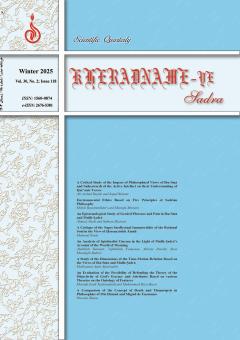An Epistemological Study of Graded Pleasure and Pain in Ibn Sīnā and Mullā Ṣadrā
Subject Areas : Studies on Mulla Sadra and the Transcendent PhilosophyAhmad Abesi 1 , Salman Shariati 2
1 - Associate Professor, Islamic Philosophy and Kalam, University of Qom, Qom, Iran
2 - PhD Candidate of Islamic Philosophy and Kalm, University of Qom, Qom, Iran
Keywords: Pleasure, pain, levels of pleasure and pain, sensory perception, imaginal perception, intellectual perception,
Abstract :
Both Ibn Sīnā and Mullā Ṣadrā consider pleasure and pain to be of the type of perception. In Ibn Sīnā’s view, perception has three stages: sensory, imaginal, and intellectual. Thus pleasures and pains are settled at the same three levels. Similar to him, Mullā Ṣadrā believes in the trinity of perception and views estimative perception as a branch of intellectual perception and, thus, places estimative pleasure and pain under intellectual ones. There are some similarities and differences between the views of these two thinkers in this regard. Some of their most important shared views include the concomitance of accidents, the particularity of the sensory perceived thing, the particularity of the imaginal perceived thing, the immateriality of the rational faculties and its perceived things, the greater strength of imaginal pleasure and pain comparing to that of sensory ones and their being weaker than intellectual pleasure and pain. Among their most crucial differences, reference can be made to the following: 1) in Ibn Sīnā’s view, the levels of perception are actualized through the process of peeling and removal of additions, while in Mullā Ṣadrā’s view this occurs through promotion and attaining the quality of the modes of superior immaterial existents; 2) in Ibn Sīnā’s view, perceived things and sensory faculties are material, and the pleasure and pain at this level of perception are also material; however, Mullā Ṣadrā maintains that sensory faculties and perceived things and, thus, their pleasure and pain are immaterial; 3) Ibn Sīnā’s image of the levels and grades of the pleasure and pain of perceptive faculties corresponds with the criterion of vertical gradedness, while Mullā Ṣadrā believes that the relationship between the grades such pleasure and pain is based on the gradedness of their manifestations.
